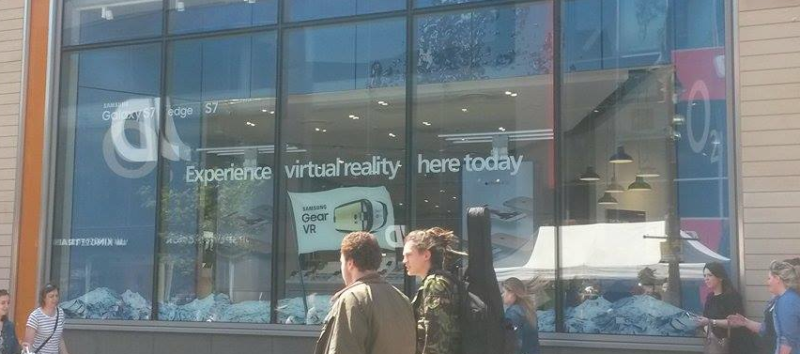This item was originally written by Sophie Buckle.
With online retailers staying one step ahead of the curve in their digital innovations‚ brick and mortar stores need to work hard to keep up. However‚ investing in innovation is a challenge that may not come intuitively to more traditional retailers.Today‚ shopping is easier than it ever has been‚ allowing us to purchase from our mobile devices‚ with next day (or even next hour) delivery and an almost unlimited variety of goods on offer. You don’t even need to leave your bed to shop online‚ let alone spend time‚ effort and money travelling to a store. That isn’t to say that physical shops don’t have a place anymore. In fact‚ they probably always will. There are some things online shopping can never offer that physical shops provide.
But nowadays it’s vital for all major shoppings brands to have a retail mobile strategy as a core part of their business plan. Simply put‚ online and ecommerce is no longer just a ‘nice to have’‚ it should be absolutely fundamental to a retailer’s business even if their focus continues to be on brick and mortar stores.I personally enjoy going shopping with friends as a social activity; we help each other choose items and usually squeeze in lunch or a coffee break too. While I love the convenience of online shopping‚ it would never be able to compete with that social experience.The power of customer experienceOur research indicates that this is what it comes down to – customer experience. If brick and mortar stores and shopping centres can provide excellent customer experiences‚ people won’t stop coming. Some effort is already being made by shops to attract customers inside. I took a trip to my local shopping centre (Eldon Square) and high street (Northumberland Street) to see what they were offering….Below is Game‚ displaying a host of electronic screens that showcase the latest games in action. This reminded me of how you used to be able to try games in store before buying.
![[object Object] [object Object]](http://images.ctfassets.net/o6514hijae09/1ziSGCKs8VcrNzK1MkaOVi/61af060b9fee7f8157852f7891ec5f0b/game_1.jpg)
Such an experience is both fun and useful for the customer‚ informing them about possible purchases. It wouldn’t surprise me if many people went in just to have a go on a new release game‚ but then saw something that caught their attention and ended up making a spur of the moment purchase.
O2 also caught my eye as I was walking past with its ‘experience virtual reality here today’ slogan. This promise of a new experience certainly provides a reason to enter the shop and find out more.
How can technology help?Blurring the divide between physical and digitalBurberry’s flagship store in London is a good example of how retailers can blur the lines between the physical and digital. The store features a huge range of technology‚ all integrated seamlessly into the retail space. It dazzles customers and attracts people from far afield‚ but few would know how many sensors and systems are communicating behind the scenes.The store uses radio-frequency identification (RFID) chips within some of the clothes and accessories so that when a customer walks to one of the screens or mirrors with the item‚ product-specific content will appear‚ such as information about how it was crafted or a video of the catwalk. This gives the customer some of the benefits of online shopping (information about the product) while also providing a really novel‚ futuristic experience that engages customers. The novelty factor will also attract new customers into the store‚ helping to advertise and spread the word about the brand.Social media spreads the wordHumans‚ in general‚ are social creatures who crave attention‚ love and a sense of identity. These are all aspects of social currency‚ and a smart retailer will take advantage of this. A good example is Starbucks: they started writing customer’s names on their cups‚ but spelled wrong. This provided a great opportunity to put humorous posts on social media‚ and so advertise Starbucks as a fun-loving‚ personable brand. Similarly‚ Coca Cola sought to engage customers with their names on the bottle campaign – people would post pictures of Coca Cola bottles featuring their friends’ names onto their social media pages. Making things ‘instagrammable’ can be a really high impact method for marketing your brand!All this goes along with making store experiences beautiful‚ special and tailored to the individual. If a shop has some really cool new tech‚ with the chance to try it out‚ people are likely to post on social media‚ and this way news spreads fast. When trying Google Glass for the first time‚ I tweeted about the experience because I thought it was cool‚ and yes‚ I wanted my friends to be jealous!Online shops working with traditional retailersIt’s worth noting that online and high street shops are not always in direct competition; online stores can help physical retailers too‚ and vice versa. For example‚ Amazon has lockers (some based in shopping centres) where you can send your online orders so you don’t miss delivery. When people come to collect their online order‚ they may also be enticed into physical shops.
![[object Object] [object Object]](http://images.ctfassets.net/o6514hijae09/4cdwMPzgpFNZFcHVVKEPOF/a93b94eb5fd23aa638da9545ab53b275/Amazon_delivery_box_1.jpg)
So‚ in conclusion I feel like physical shops aren’t going anywhere any time soon‚ but if they want to avoid losing a lot of business to online retailers‚ they may want to put considerable thought and into researching how to innovate and improve their customers’ experiences.





